On a well-designed motor-yacht, it is possible to sleep peacefully in a stateroom immediately forward of an engine room containing two, 1,000-hp. diesel engines and a couple of large gensets, while cruising at 20+ knots. The noise level at 1′ from the engine room bulkhead is often less than 74 dbA. In comparison, the auxiliary engine on a typical sailboat often creates a din, both belowdecks and in the cockpit. If such low sound levels can be achieved on a motoryacht, why must we tolerate high noise levels from our 50-100-hp. sailboat engines? Can the aft engine room design that is largely responsible for low noise on motoryachts also work on sailboats, even those only 30 or so feet in length?
Noise is a form of energy. Eliminating it requires trapping and converting it into some other less intrusive form of energy. Sound, like water, will leak through even very small holes. To be effective, the enclosure must be carefully sealed, virtually air- tight, with all necessary air passages sound trapped. A proper sound shielding system will convert trapped sound energy into heat.
Unfortunately, in the typical sailboat engine installation, inspection and maintenance access requirements, as well as its proximity to the bilge, make shielding difficult. The result is noise pollution. An aft engine room, with just one easily sealed bulkhead between the machinery and the remainder of the interior greatly simplifies the noise elimination task.
Aft engine installations for sailboats are usually dismissed for two reasons: Putting all that weight so far aft will severely impact the pitch axis of the boat, and make it difficult to convey engine power to the prop.
Lets examine these assumptions.
Weight in the ends can create undesirable pitching moments. However, when the weight distribution common on many cruising sailboats is examined, we find that an aft engine installation may not be an extreme problem. The bow often carries a substantial load of anchors, windlass and chain. The lazarette often contains a few hundred pounds of stuff, plus the weight of an outboard motor on the stern rail and occasionally a dinghy hanging on davits. Despite this, acceptable pitch axis response is being achieved. Perhaps the weight of an aft engine installation does not pose a severe problem.
Modern diesel engines are remarkably light. A typical 50-hp., 4 cylinder diesel engine weighs only 498 lbs., complete with marine gear. The 100-hp. version of this engine weighs 542 lbs. with gear. For the smaller boats, a 38-hp. engine weighs 400 lbs. and a 27-hp. engine about 300 lbs. Relocating some of the items typically stowed in the lazarette and careful hull design should make it possible to handle the weight of the aft engine installation. Variable weights, fuel and water tankage, whose changes can adversely affect fore and aft trim, can be placed low in the center of the boat, in part of the space previously occupied by the engine.
Driving the propeller with an engine mounted far aft is challenging. Using a V-drive may be possible, but not attractive for three reasons: (1) for low-speed maneuvering under power, the prop is best positioned ahead of the rudder, (2) a V-drive may impose an unacceptable restraint on rudderpost location, and (3) V-drives can place the stuffing box beneath the engine, where access is next to impossible. Coupling the engine to the prop with a hydraulic system can eliminate these problems and provide additional benefits.
Any proposal to use hydraulics to drive props on boats usually brings forth a number of negative reactions:
too expensive
inefficient when compared with a mechanical transmission.
can be very noisy
can leak and make a terrible mess
difficult to maintain and troubleshoot
In the main, these comments are not correct.
Cost
Quality hydraulic systems are expensive, but compared to the total cost of the vessel they are not as costly as one might think, especially given offsetting savings. The cost of the hydraulic machinery for a sailboat is typically only a small part of the total cost of the boat. For boats in the 35′ to 45′ range, the hydraulic pump and the motors needed to propel the boat and power an 8-kW alternator cost less than $3,000. The additional items needed to complete the system-control valves, hydraulic reservoir/cooler, a hydraulic motor to power the wind lass and various hoses and fittings-will add another $1,500 to $2,000. As side benefits, a hydraulically powered bow thruster can be added, usually for substantially less money than an electric unit. And using the existing hydraulics to power sheet winches is surprisingly inexpensive.
Efficiency
The overall efficiency of the hydraulic system is less than that of a conventional mechanical system, which is generally on the order of 93%-95% (it is the conversion of energy into heat by the gear sets which creates the need for cooling of marine gears). By comparison, the hydraulic system will likely operate at no more than about 75%-80% efficiency, an apparent deficit of up to 20%. However, optimum propeller positioning, possible with the use of hydraulics, will recover a part of this deficit. The bottom line is a trade-off between lower power transmission efficiency and the benefits of the aft engine room and other worthwhile hydraulic power system advantages. This trade-off is similar to the use of automatic transmissions in cars, even though they are less efficient than manual gear boxes.
Noise
Hydraulic pumps and motors can be noisy beasts. However, in a properly sound-isolated engine room, a hydraulic pump should hardly be noticeable from outside. Motors capable of delivering 50-hp. are less than 8″ in diameter and slightly more than 1′ long. Because no routine access is needed, the motor can be encapsulated in an effective sound shield.
The use of the hydraulic power system also permits superior vibration isolation. There is no need to align the engine with the prop shaft. The entire engine/hydraulic system can be placed on soft, vibration-isolating mounts.
Leaks
Yes, leaks can occur, just as shorts can occur in electrical systems. But they are not a valid reason to rule out hydraulic power transmission.
Reliability & Maintenance
Hydraulic systems are ideal for use in the marine environment. By their nature they are well sealed and already filled with a rust preventative material.
The extensive use of hydraulics on fishing and commercial vessels testifies to their relative immunity to the saltwater environment, and their ultimate reliability. The operation of the hydraulic system is, in many instances, easier to understand than an electrical system of equal capability.
The maintenance of a hydraulic system can be simpler than for some conventional mechanical gear boxes. Periodic hydraulic fluid filter changes and occasional inspection of pipes, hoses and connectors is all that is normally required. The modest service requirement of the power steering system in an automobile is as an example of what to expect with a properly designed hydraulic system.
Propulsion Benefits
Sailboat and most powerboat propeller installations require a prop shaft installed at an angle in order to provide even minimum required prop tip-to-hull clearance. This downward angle causes two problems-loss of efficiency due to the downward component of thrust, and the P factor, a lateral offset in thrust that requires compensating rudder offset. The compact hydraulic propeller motor permits use of a horizontal prop shaft. There will be no more P factor to cope with, no need for rudder offset when powering ahead, no detrimental offset thrust when maneuvering astern. With increased freedom in prop location it is also possible to install a more efficient propeller. Increasing prop tip-to-hull clearance will also reduce noise and vibration transfer to the hull.
The ability of the hydraulic motor to provide large amounts of torque at stall simplifies the choice of an optimum propeller. The gear ratio between the engine and the prop is set by the ratio of pump to motor displacement. For example, a 2:1 ratio can be had by using a 2.5-cubic inch per revolution pump with a 5-cubic inch per revolution motor.
Lets assume the hydraulic system is intended for a 42′ sailboat powered with a 50-hp. diesel engine that has a maximum rated speed of 3,600 rpm. The pump required for use with a 50-hp. engine is quite small, lightweight and not too expensive. An Eaton Model 70422, pressure-flow compensated, 2.32-cubic inch per revolution hydraulic pump weighs only 27 lbs., is less than 10″ long and 7″ in diameter. This $1,211 pump can power the propeller and at any time when less than full power is needed for the propeller, also power an 8-kW alternator, a bow thruster, an anchor windlass and various other loads, such as watermaker pumps, scuba compressors, sheet winches or dinghy davit hoists. Because the maximum rated speed for this pump is 2,700 rpm, we will choose a gear ratio of 1.33:1.
The propeller is driven by a 5.04-cubic inch fixed displacement Eaton Model 74624 motor. This $1,023 motor delivers maximum horsepower at 1,350 rpm. The virtually flat torque curve of a hydraulic motor simplifies prop choice. The motor weighs 24 lbs. and is just over 8″ long and less than 7″ in diameter.
Control of propeller speed and direction or rotation can be accomplished with the use of directly actuated hydraulic control valves. An attractive alternative is the use of electrically actuated valves that permit a joy stick for control of both the propulsion propeller and the hydraulically powered bow thruster. This control arrangement is common on many large yachts and an increasing numbers of commercial vessels.
At anchor, the main engine can easily provide the 14 horsepower consumed by an 8-kW alternator. A typical 50-hp. engine need turn only about 1,400 rpm to deliver the needed power. As noted, a hydraulic pump on the genset engine provides back-up propulsion in the event of main engine failure.
Installation Considerations
Compared to the typical sailboat engine installation, the aft engine room will be a delight, affording easy, immediate and total access to every part of the engine, with spares stowed close at hand. On many cruising boats, compartment width will be on the order of 5′ to 8′, with a fore and aft dimension approaching 3′. The deck hatch can provide full access to this apace. A typical 50-100-hp. marine diesel engine, with marine gear, is only 37″ long, 23″ wide and 26″ high. The hydraulic pump will add about 10″ to overall length. Transverse mounting of the engine may be attractive. In addition to the pump, space will be needed for the fluid reservoir, filter and heat exchanger. System installation will be simplified by use of flexible, high-pressure hydraulic lines.
An engine room blower system, providing pressurized ambient temperature air, works wonders for both performance and equipment life. The power output of a diesel engine depends on the density of the charge air. Most engines are rated at an air temperature of 77F. In practice, the air temperature in many sailboat engine spaces reaches 122F, resulting in a decrease in available power of almost 5%. Exhaust back pressure is a constant challenge to sailboat designers. With the engine in the middle of the boat, long and sometimes torturous exhaust systems are needed, adding back pressure and reducing engine power. Designing an ideal exhaust system for an aft engine is simple.
The electric starting motor on the engine can be replaced with a hydraulic motor. When a start is desired, hydraulic energy stored in an accumulator is delivered to the starting motor. With the addition of a hand-operated emergency pump to recharge a depleted accumulator, an engine start can be made even with dead batteries.
Overall Cost
For our hypothetical 42-footer, the list price for the components of a total hydraulic propulsion system (not counting the 50-hp. diesel), including the main pump, prop motor, valves, fittings, reservoir, filter and hoses is less than $3,500. The cost of adding an 8-kW alternator is less than $2,000, a substantial savings when compared with conventional gensets. The cost of powering the windlass, a bow thruster or miscellaneous loads such as dive compressors and watermaker pumps will likely be less than using electric motors.
Conclusion
The aft engine room recognizes this inescapable fact of life: Whatever we put in a boat will eventually wear out, break down or rust away. Regardless of how or why it fails, everything may eventually need to be removed and replaced.
Which scenario would you rather deal with? An engine in the middle of the boat surrounded by expensive cabinetry, under the cockpit or deck, or one in its own hole in the back of the boat, immediately accessible by opening a hatch which when lifted reveals all? In fact, on a ketch,the mizzen mast and boom could even form a built-in engine removal/reinstallation system.
Contacts- Eaton Corp., Hydraulics Division, 15151 Highway 5, Eden Prairie, MN 55344; 612/937-9800.




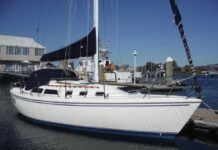








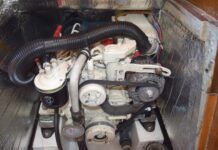
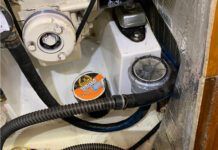

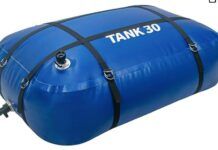

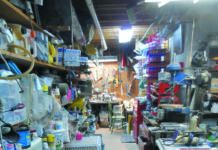
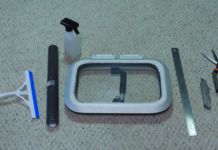












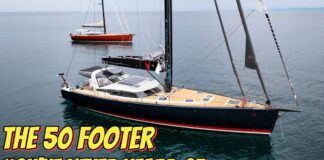



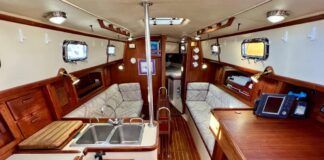
Thank you for your article, as I’m building a Bruce roberts PCF40 motor sailor, it’s going to have a 110hp diesel running a hydraulic propulsion system which will include hydraulic windlass, winches and cranes, I’m just doing the sizing up of hydraulic pump and motor combination. It has a 22” diameter/ 19” pitch prop, would you be able to recommend a starting point for hydraulic pump and motor combination with the following info?
17 ton boat weight
110hp diesel
22”diameter/19” pitch prop
Hull speed 7knots approximately
Most of the time I will be sailing or cruising at 5knots between anchorages.
Thank you
Mick